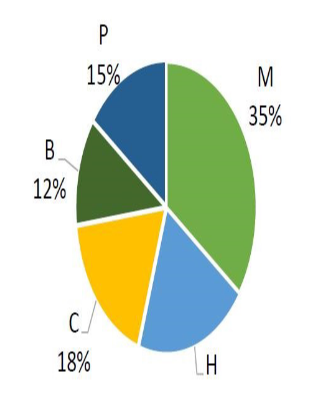- Communication Ability-6
- Communication Ability-5
- Communication Ability-4
- Communication Ability-3
- Communication Ability-2
- Communication Ability-1
- Statistical Ability-1
- Algebraic and Geometrical Ability-3
- Algebraic and Geometrical Ability-2
- Algebraic and Geometrical Ability-1
- Date and Time Arrangement Problems-2
- Date and Time Arrangement Problems-1
- Coding and Decoding-2
- Coding and Decoding-1
- Series-2
- Series-1
- Odd Things Out-2
- Odd Things Out-1
- Analogy-2
- Arithmetic Ability-3
- Arithmetic Ability-2
- Data Analysis-2
- Data Sufficiency-3
- Data Sufficiency-2
- Analogy-1
- Arithmetic Ability-1
- Data Analysis-1
- Data Sufficiency-1
Question: 11
A survey conducted on 210 persons about the readership of three dailies I, H, J, revealed the following information.
80 read I, 95 read H, 85 read J. The number of people who read H and J but not I is three times that of who read all the three. The number of people who read only J is 40. The number of people who read J and I is 5 more than that who read all the three. The number of people who read I and H but not J is 5 less than that of who read all the three.
మూడు దిన పత్రికలు I, H, J లను చదివేవారికి సంబంధించి 210 వ్యక్తుల పై నిర్వహించిన ఒక సర్వే లో క్రింది సమాచారం లభించింది. ఇందులో 80 మంది I ని చదువుతారు, 95 మంది H
ని చదువుతారు, 85 మంది Jని చదువుతారు. H మరియు J లను చదువుతూ I చదవని
వారి సంఖ్య అన్ని మూడింటిని చదివే వారి సంఖ్య కు మూడు రెట్లు. J మాత్రమే చదివే వారి సంఖ్య 40. J మరియు I లను చదివే వారి సంఖ్య మూడింటినీ చదివే వారి సంఖ్య కన్నా 5 ఎక్కువ. I మరియు H లను చదువుతూ J ని చదవని వారి సంఖ్య మూడింటినీ చదివే వారి సంఖ్య కన్నా5 తక్కువ.
The number of people who read only I is
I ను మాత్రమే చదివే వారి సంఖ్య
60
65
68
69
Answer: 1
60
Question: 12
A survey conducted on 210 persons about the readership of three dailies I, H, J, revealed the following information.
80 read I, 95 read H, 85 read J. The number of people who read H and J but not I is three times that of who read all the three. The number of people who read only J is 40. The number of people who read J and I is 5 more than that who read all the three. The number of people who read I and H but not J is 5 less than that of who read all the three.
మూడు దిన పత్రికలు I, H, J లను చదివేవారికి సంబంధించి 210 వ్యక్తుల పై నిర్వహించిన ఒక సర్వే లో క్రింది సమాచారం లభించింది. ఇందులో 80 మంది I ని చదువుతారు, 95 మంది H
ని చదువుతారు, 85 మంది Jని చదువుతారు. H మరియు J లను చదువుతూ I చదవని
వారి సంఖ్య అన్ని మూడింటిని చదివే వారి సంఖ్య కు మూడు రెట్లు. J మాత్రమే చదివే వారి సంఖ్య 40. J మరియు I లను చదివే వారి సంఖ్య మూడింటినీ చదివే వారి సంఖ్య కన్నా 5 ఎక్కువ. I మరియు H లను చదువుతూ J ని చదవని వారి సంఖ్య మూడింటినీ చదివే వారి సంఖ్య కన్నా5 తక్కువ.
The number of people who read only H is
H ను మాత్రమే చదివేవారి సంఖ్య
35
40
45
50
Answer: 4
Question: 13
A survey conducted on 210 persons about the readership of three dailies I, H, J, revealed the following information.
80 read I, 95 read H, 85 read J. The number of people who read H and J but not I is three times that of who read all the three. The number of people who read only J is 40. The number of people who read J and I is 5 more than that who read all the three. The number of people who read I and H but not J is 5 less than that of who read all the three.
మూడు దిన పత్రికలు I, H, J లను చదివేవారికి సంబంధించి 210 వ్యక్తుల పై నిర్వహించిన ఒక సర్వే లో క్రింది సమాచారం లభించింది. ఇందులో 80 మంది I ని చదువుతారు, 95 మంది H
ని చదువుతారు, 85 మంది Jని చదువుతారు. H మరియు J లను చదువుతూ I చదవని
వారి సంఖ్య అన్ని మూడింటిని చదివే వారి సంఖ్య కు మూడు రెట్లు. J మాత్రమే చదివే వారి సంఖ్య 40. J మరియు I లను చదివే వారి సంఖ్య మూడింటినీ చదివే వారి సంఖ్య కన్నా 5 ఎక్కువ. I మరియు H లను చదువుతూ J ని చదవని వారి సంఖ్య మూడింటినీ చదివే వారి సంఖ్య కన్నా5 తక్కువ.
The number of people who read all the three is
అన్ని మూడు పత్రికలను చదివే వారి సంఖ్య
9
10
11
12
Answer: 2
Question: 14
A survey conducted on 210 persons about the readership of three dailies I, H, J, revealed the following information.
80 read I, 95 read H, 85 read J. The number of people who read H and J but not I is three times that of who read all the three. The number of people who read only J is 40. The number of people who read J and I is 5 more than that who read all the three. The number of people who read I and H but not J is 5 less than that of who read all the three.
మూడు దిన పత్రికలు I, H, J లను చదివేవారికి సంబంధించి 210 వ్యక్తుల పై నిర్వహించిన ఒక సర్వే లో క్రింది సమాచారం లభించింది. ఇందులో 80 మంది I ని చదువుతారు, 95 మంది H
ని చదువుతారు, 85 మంది Jని చదువుతారు. H మరియు J లను చదువుతూ I చదవని
వారి సంఖ్య అన్ని మూడింటిని చదివే వారి సంఖ్య కు మూడు రెట్లు. J మాత్రమే చదివే వారి సంఖ్య 40. J మరియు I లను చదివే వారి సంఖ్య మూడింటినీ చదివే వారి సంఖ్య కన్నా 5 ఎక్కువ. I మరియు H లను చదువుతూ J ని చదవని వారి సంఖ్య మూడింటినీ చదివే వారి సంఖ్య కన్నా5 తక్కువ.
The number of people who do not read any of three paper is
మూడు దిన పత్రికలలో వేటినీ చదవని వారి సంఖ్య
8
9
10
11
Answer: 3
Question: 15
The following pie chart shows the percentages of number of students studying five courses Mathematics (M), Humanities (H), Physics (P), Biology(B), Chemistry (C) in a college for the year 2023.
ఈ క్రింది పీ చిత్రం ఒకానొక కళాశాలలో 2023వ సంవత్సరములో ఐదు కోర్సులు గణితం(M), మానవీయ శాస్త్రాలు (H), భౌతిక శాస్త్రం (P), జీవశాస్త్రం (B), రసాయన శాస్త్రం (C) లను చదివే విద్యార్థుల శాతాలను సూచిస్తుంది.

What is the ratio between the number of students studying Physics and the total number of students studying Chemistry and Biology?
భౌతిక శాస్త్రం చదివే విద్యార్థుల సంఖ్యకు, రసాయన శాస్త్రం మరియు జీవ శాస్త్రాలు చదివే విద్యార్థుల మొత్తం సంఖ్యకు గల నిష్పత్తి
10:9
2:1
9:10
1:2
Answer: 4
1 : 2
